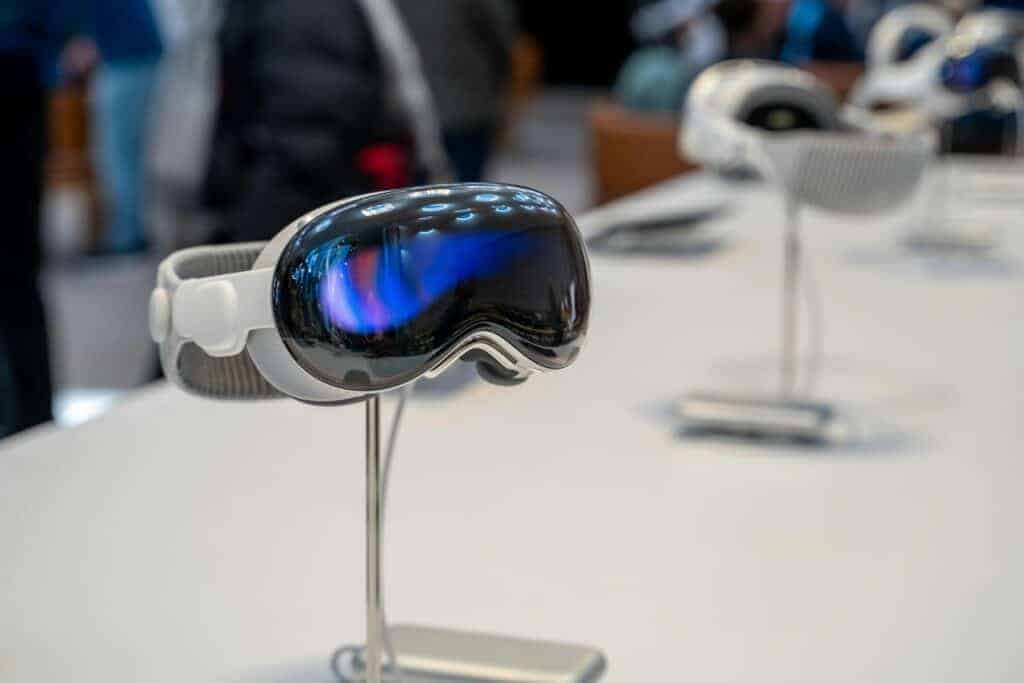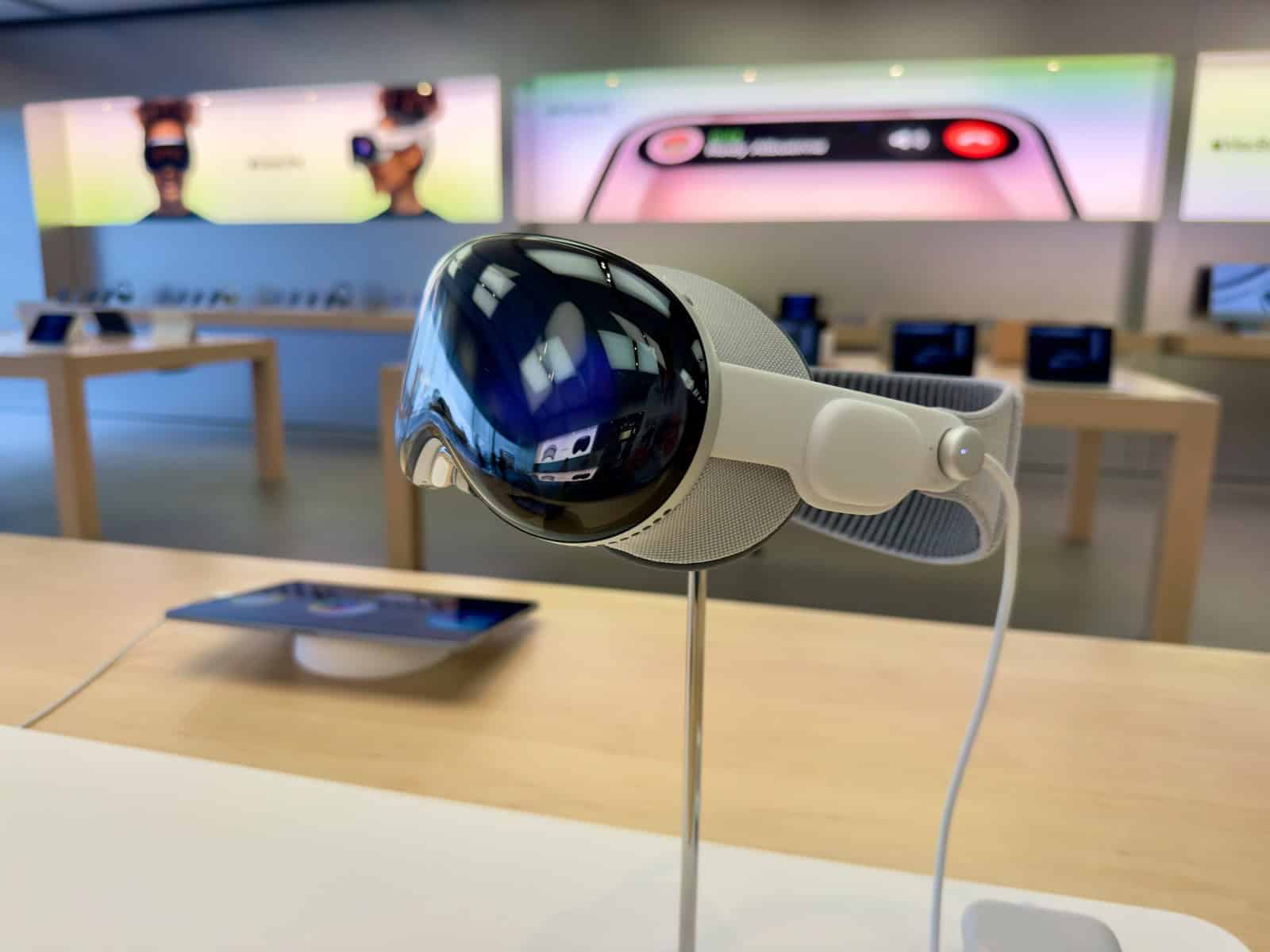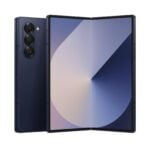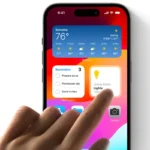When Apple unveiled the Vision Pro in early 2024 it felt like the first true “post-iPhone” device—an unabashedly futuristic headset that swapped the familiar touch screen for eye-tracking, hand gestures, and an ultra-sharp micro-OLED display. Eighteen months later, the headset is still pricey at $3,499, but the conversation around it has shifted from “Is this thing for real?” to “How soon can Apple make it lighter, faster, and cheaper?” Below is a snapshot of what’s new, what’s coming, and why the Vision Pro remains the reference point for spatial computing.
The Headset Today: An Immersive Work-and-Play Machine
Early adopters describe the display quality as “retina for each eye,” with text rendering crisp enough for full-day productivity and color reproduction good enough for Hollywood-grade HDR. Onboard dual-driver audio pods create a surprisingly convincing spatial soundstage, while the passthrough cameras deliver latency low enough that you forget you’re wearing a ski-goggle-sized computer—until the battery pack tugs at your pocket after two hours.

Developers have responded with more than 3,000 native apps. Productivity standouts include Figma’s multi-user white-boarding room, Microsoft’s full Office suite in floating panes, and the newly launched Adobe ChronoEdit that lets video editors scrub a timeline as if it were a physical ribbon stretched across their desk. Entertainment options are equally headline-worthy: Disney+ streams remastered Marvel movies in a 15-metre virtual theater, while the NBA courtside app lets you “sit” opposite the scorer’s table for every Finals game.
Hardware Iteration: A Refined Vision Pro Arrives Late 2025
Multiple supply-chain reports point to a quietly updated Vision Pro—call it “Vision Pro (2025)”—shipping before the holidays. The headline changes are an M4-class chip (up from the launch-day M2) and a re-engineered knit strap that redistributes weight toward the crown of the head. Apple isn’t expected to tweak the dual-chip architecture—the dedicated R1 image-processing silicon remains—but the move to M4 should unlock heavier AI workloads, including real-time environment meshing and on-device large-language-model tasks Siri currently hands off to the cloud.
Despite speculation about a lower sticker price, insiders say Apple is holding the line at $3,499 for this interim model, banking on component savings to protect margins while it scales production.
visionOS 26: Making the Real World the Default Desktop
Now in its third developer beta, visionOS 26 is the biggest software leap since launch. Key additions:
- Spatial Widgets – Drop persistent Weather, Calendar, or Stock tiles onto your coffee table; they sit exactly where you leave them between sessions.
- Look-to-Scroll – Gaze a few pixels below the bottom of any scrollable window and content glides naturally, freeing your hands for a trackpad-style pinch-zoom.
- Enhanced Personas – Apple’s lifelike avatars now capture cheek micro-expressions and subtle eye crinkles, making FaceTime calls feel less “plastic.”
- Generative Spatial Scenes – A single panoramic photo blossoms into a 3-D diorama using on-device diffusion models, ideal for immersive memory-sharing.
- Shared Spaces & Controller Support – Up to five headsets sync inside the same mixed-reality room, and the PlayStation VR2 Sense controller joins Apple’s own gesture system for game developers.
Public beta arrives later this summer, with a polished release expected alongside the iPhone launch cycle in September.
Enterprise Momentum and Real-World Use
While the hardware’s price keeps it in early-adopter territory, enterprise pilots are pushing the Vision Pro into factory floors and surgery theaters. Delta is trial-testing maintenance overlays that float wiring diagrams on real jets, Walmart’s training division replaced 2-D “box” simulations with spatial customer-service scenarios, and a Mayo Clinic study found Vision Pro’s stereoscopic imaging cut operating-room prep time by 30 percent for certain orthopedic procedures.
The Roadmap: Lighter, Cheaper, Everywhere
Apple’s long-term plan looks like a three-tier lineup:
- Vision Pro (refined) – The M4 upgrade shipping late 2025.
- Vision Pro 2 (2026–2027) – A true second generation that reportedly sheds at least 150 grams, swaps glass for a carbon-fiber-reinforced frame, and introduces pancake lenses to shrink the visor depth.
- Apple “Visor” or Smart Glasses (around 2027) – A mainstream, everyday-wearable pair of smart glasses delivering glanceable notifications and basic AR overlays, aimed squarely at Meta’s Ray-Ban line but running a slimmed-down visionOS.
Global availability is expanding in lockstep: after the nine-country launch wave in mid-2024, retail leaks suggest Brazil, South Korea, and Spain will see Vision Pro store demos by early 2026.
The Bottom Line
Even at luxury pricing, Vision Pro’s blend of hand-tracking, eye-tracking, and spatially aware apps has become the yardstick for mixed reality. With a faster chip and lighter build on the horizon—and visionOS rapidly maturing—the real question is not whether Apple can win the headset market, but how quickly it can shrink the tech into something you’d wear in public without a second thought.
Key Takeaways
- The Apple Vision Pro offers excellent visual quality but comes with a steep $3,499 price tag.
- Users can interact with apps and content using just eye and hand movements thanks to the innovative VisionOS.
- The headset excels as a wearable display for movies and photos but has room for improvement in battery life and comfort.
Design and Build Quality
Apple’s Pro devices set the standard for premium construction with attention to detail in every aspect. The meticulous craftsmanship is evident in both the physical form and how the devices feel when handled.
Materials and Ergonomics
The Apple Pro lineup features matte-finished materials that resist fingerprints and provide a secure grip. The iPhone 16 Pro maintains Apple’s traditional flat design while adding comfort through precisely rounded edges. This attention to ergonomics makes extended use more comfortable.
The Vision Pro headset shows similar care in its design. The light seal adapts to different face shapes, creating a personalized fit that blocks outside light while remaining comfortable for extended wear. This design choice enhances immersion without sacrificing comfort.
Weight distribution plays a key role in all Pro devices. The balanced design prevents fatigue during long sessions, whether working on a MacBook Pro or using the Vision Pro headset.
Aesthetic Appeal and Color Options
Apple’s Pro devices feature a refined, minimalist aesthetic that stands out in a crowded market. The excellent design communicates premium status at first glance through clean lines and symmetrical elements.
Color options typically include:
- Silver – Classic, versatile finish
- Space Black – Sophisticated, subtle appearance
- Deep Blue – Professional yet distinctive
- Natural Titanium – Modern, lightweight material
The Pro lineup avoids flashy finishes in favor of colors that maintain professional appeal. These subdued tones complement the devices’ premium positioning in Apple’s ecosystem.
The Vision Pro headset features a seamless front panel with curved glass that flows into the aluminum frame. This design choice creates a distinctive look unlike typical VR headsets, emphasizing Apple’s focus on blending technology with fashion-forward design.
Display Specifications
The Apple Pro Display XDR offers exceptional visual performance with technical specifications that set it apart from standard monitors. Its screen capabilities provide professionals with the tools needed for high-end creative work.
Screen Resolution and Dynamic Range
The Pro Display XDR features an impressive 6K resolution (6016 x 3384 pixels), providing incredible detail for professional workflows. This high pixel density ensures that text appears crisp and images show fine details even when viewed up close.
The monitor’s dynamic range capabilities are remarkable, with 1,600 nits of peak brightness for HDR content. It can maintain 1,000 nits of full-screen brightness indefinitely, unlike many displays that can only achieve peak brightness in small areas.
The contrast ratio far exceeds typical LCD monitors. While standard IPS displays usually offer 1000:1 contrast ratios, the Pro Display XDR uses advanced backlighting technology to achieve much higher contrast levels.
Apple’s display provides a wide field of vision with minimal color shifting when viewed at angles. This consistency is crucial for collaborative professional environments where multiple people might view the screen simultaneously.
HDR and Color Accuracy
The Pro Display XDR excels in HDR performance, supporting multiple HDR formats including HDR10 and Dolby Vision. This makes it ideal for video editing professionals working with high-dynamic-range content.
Color accuracy is exceptional, with the display offering P3 wide color gamut coverage. It displays billions of colors with remarkable precision, essential for color-critical work in photography, video, and design.
Each Pro Display XDR undergoes factory calibration to ensure color consistency. Users can trust that what they see on screen accurately represents their work without requiring frequent recalibration.
The display supports multiple reference modes including:
- Photography (P3-D65)
- Digital Cinema (P3-DCI)
- Design and Print (P3-D50)
- HDR Video (BT.2020)
These preset modes allow professionals to quickly switch between different color spaces based on their current project needs.
Performance and Hardware
Apple’s Pro devices stand out with their impressive mix of power and efficiency. The hardware specs deliver smooth performance for demanding tasks, while offering decent battery life for professionals on the go.
Processing Power and Storage Options
The Apple M1 Pro chip has proven to be a powerhouse in real-world applications. Tests show it excels in productivity applications and beats many Intel and AMD options in performance per watt. For professionals working with video editing or 3D rendering, this means less waiting and more creating.
Storage options typically range from 256GB to 8TB SSD, with the higher-end models offering blazing-fast read/write speeds. This makes a big difference when working with large files.
The M2 Pro and M2 Max processors found in newer MacBook Pro models push performance even further. These chips handle multiple 4K video streams without breaking a sweat.
RAM configurations start at 8GB and go up to 64GB for power users. The unified memory architecture gives these machines an edge in memory-intensive tasks.
Battery Life and Charging Capabilities
Battery performance is a highlight of Apple’s Pro lineup. The MacBook Pro with M1 Pro can last 14-17 hours of regular use on a single charge. This beats most Windows laptops by a wide margin.
The M2 Pro and M2 Max MacBooks continue this tradition with “excellent performance, long battery life.” Many users report getting through a full workday without needing to plug in.
Fast charging is another plus. With the right power adapter, users can get about 50% battery in just 30 minutes. This is perfect for busy professionals who need a quick boost between meetings.
Battery optimization is built into the system. Background apps are managed efficiently, and the system adjusts power use based on tasks. The MacBook Pro’s battery health management feature also helps extend the battery’s lifespan over years of use.
Camera System
Apple’s Pro lineup continues to push mobile photography forward with significant camera improvements. The new models feature enhanced sensors, better low-light performance, and more intuitive controls for both casual and serious photographers.
Main and Telephoto Cameras
The main camera on the latest Apple Pro devices sports a 48-megapixel sensor with improved light gathering capabilities. This camera captures stunning detail in both bright and dim settings. Users can shoot in full 48MP ProRAW format for maximum editing flexibility.
The faster sensor readout times in the new Apple Camera Interface allow for improved motion capture. This means less blur when photographing moving subjects like children or pets.
Portrait mode now works automatically without switching modes. The camera detects people, pets, and objects then creates depth information on the fly. Photos can be adjusted for focus and depth effects even after taking the shot.
The telephoto lens offers 3x optical zoom on standard Pro models and 5x on larger Pro Max versions. This longer reach helps capture distant subjects with impressive clarity. Night mode now works across all lenses, including telephoto.
Ultrawide and Lidar Scanner
The ultrawide camera received significant upgrades with a wider f/1.8 aperture that lets in more light. This 12MP shooter captures expansive landscapes and tight indoor spaces with minimal distortion. Macro photography remains a standout feature, letting users focus on subjects as close as 2cm.
Apple enhanced computational photography for the ultrawide lens. It now produces sharper edges and better color accuracy in challenging lighting conditions. The lens correction happens automatically to prevent warping at the frame edges.
The Lidar Scanner works alongside the cameras to measure depth precisely. This technology improves autofocus speed in low light and enhances AR experiences. The scanner helps the camera system quickly find focus even in near-darkness.
Night mode photography benefits greatly from the Lidar Scanner’s abilities. The system can detect subject outlines in the dark, resulting in better exposures and clearer details. This combination of hardware and software delivers exceptional results in challenging conditions.
Software and User Interface
The Apple Vision Pro delivers a unique software experience through its eye and hand tracking capabilities. The system offers both impressive native functionality and integration with third-party applications, though with varying degrees of success.
VisionOS and Native Apps
VisionOS presents a beautiful and intuitive interface that feels fresh yet familiar to Apple users. The eye and hand tracking works remarkably well, creating a natural way to interact with content without controllers. Apple’s native apps shine on the platform, taking full advantage of the spatial computing environment.
Users navigate by looking at app icons and pinching to select them. This gesture system works consistently across the interface. Safari provides an expansive browsing experience, while Photos displays memories in stunning detail on the high-resolution displays.
FaceTime offers a unique spatial presence, though the digital personas still look somewhat unnatural. Apple TV creates a virtual cinema experience that’s truly impressive.
Third-Party App Integration and Control Center
Third-party app support remains a work in progress. While some apps have been optimized for VisionOS, many run as iPad apps in windows. This creates an inconsistent experience, as these apps don’t fully utilize the spatial environment.
The Control Center provides quick access to essential functions through a simple gesture. It includes brightness controls, volume adjustment, and connectivity options. Getting to settings feels intuitive after a short learning period.
App switching works well, though interface errors can be jarring given that Vision Pro completely takes over your vision. The multitasking capability allows for impressive workspace setups with multiple apps arranged in space.
Voice control supplements the gesture system effectively, especially for text input. The five-microphone array ensures commands are captured clearly even in noisy environments.
Audio and Microphone Quality
The AirPods Pro deliver impressive audio performance and reliable microphone capabilities for various uses. Both aspects have seen improvements in the second generation model, addressing key concerns users had with earlier versions.
Spatial Audio and Sound Clarity
Spatial Audio on the AirPods Pro creates an immersive listening experience that makes music and movies feel more three-dimensional. This feature uses dynamic head tracking to maintain sound orientation even when you move your head.
The sound quality is notably crisp with well-balanced bass that doesn’t overpower the mids and highs. Users report clearer instrument separation compared to standard earbuds.
The noise cancellation technology effectively blocks external sounds, enhancing the listening experience in noisy environments. This works especially well for low-frequency sounds like airplane engines or office humming.
Battery life remains strong even with these advanced audio features enabled. The second-generation AirPods Pro have improved the overall audio profile with deeper bass and more detailed highs.
Microphone Performance for Calls and Video Chats
The microphone quality on AirPods Pro has been a point of contention among users. The second-generation AirPods Pro offer better voice pickup in quiet environments, sounding more natural than their predecessors.
However, performance can decline when background noise enters the picture. Users report that background noise can sometimes be too loud during calls, which might distract the person on the other end.
For video chats and conference calls, the microphones perform adequately in quiet settings. Multiple microphones work together to focus on your voice and attempt to reduce ambient noise.
Mic tests show the AirPods Pro 2 handle business calls reasonably well, though they aren’t perfect. For professional use, they work best in controlled environments rather than busy public spaces.
Wind noise reduction has improved in newer models, making outdoor calls more feasible than before.
Connectivity and Ports
The latest MacBook Pro models offer a robust selection of connectivity options that balance versatility with performance. Port selection has significantly improved in recent generations, addressing previous limitations while enhancing wireless capabilities.
USB-C Implementation and Compatibility
The MacBook Pro features three USB-C ports that utilize Thunderbolt technology. These ports support high-speed data transfer, display output, and charging capabilities all through a single connection type.
Each USB-C port delivers up to 40Gbps of bandwidth, making them ideal for connecting external drives and displays. Users can connect multiple 4K monitors or a single 6K display, depending on their workflow needs.
The ports are backward compatible with older USB standards when using appropriate adapters. This ensures users can still connect legacy devices without replacing their entire peripheral collection.
Power delivery through these ports is remarkably efficient. The MacBook can be charged through any of its USB-C ports, offering flexibility in desk setup and cable management.
Wireless Connectivity and Range
Wireless capabilities on the MacBook Pro have been significantly enhanced with the latest Wi-Fi 6E support. This provides faster speeds and reduced latency compared to previous generations.
Bluetooth 5.3 technology enables reliable connections with wireless peripherals like mice, keyboards, and headphones. The improved range allows users to maintain stable connections even when working at a distance from their devices.
AirDrop functionality works seamlessly for quick file transfers between Apple devices. This wireless feature has become essential for many professionals working across multiple Apple products.
The MacBook Pro also supports Facetime with impressive video quality. The built-in wireless capabilities enhance video conferencing experiences, making remote collaboration more effective.
Connection to Apple TV+ and other streaming services benefits from the robust wireless implementation, ensuring smooth playback without buffering issues.
Augmented and Virtual Reality
The Apple Vision Pro blends cutting-edge AR and VR technologies with innovative tracking systems to create a unique spatial computing experience. The device brings a new level of immersion that changes how users interact with digital content.
AR and VR Integration with Spatial Computing
Apple Vision Pro offers immersive experiences that blend the digital and physical worlds. The headset doesn’t just display virtual content – it anchors digital objects in your real space through spatial computing.
The micro-OLED displays deliver stunning visual quality that makes virtual content look incredibly real. Users can easily switch between full immersion and passthrough modes.
In passthrough mode, cameras show your surroundings while adding digital elements. This creates a mixed reality experience where virtual windows float in your actual room.
The Vision Pro differs from typical VR headsets by focusing on augmented experiences rather than complete virtual worlds. This approach lets users stay connected to their environment while enjoying digital content.
Eye Tracking and Hand Tracking Features
The Vision Pro uses advanced eye-tracking technology that follows your gaze to select items. This natural interface feels almost magical – you simply look at something and pinch to select it.
Hand tracking enables gesture controls without controllers. The system recognizes finger movements with impressive accuracy, letting you tap, swipe, and manipulate virtual objects naturally.
These tracking systems work together to create an intuitive experience. You can resize windows by looking at them and using pinch gestures to adjust their dimensions.
The technology reduces the learning curve significantly. Most users quickly adapt to the eye and hand tracking controls, making complex interactions feel simple and natural.
Gaming and Immersive Experiences
The Apple Vision Pro offers unique gaming experiences and impressive immersive content capabilities that set it apart from other headsets. Its high-resolution displays and advanced tracking systems create standout visual experiences.
Performance in Gaming Scenarios
The Vision Pro’s gaming performance shows both strengths and limitations. The headset uses eye tracking and hand gestures for control, creating an intuitive gaming experience without controllers. This system works well for casual games but might feel less precise for action titles.
Games designed specifically for the Vision Pro look stunning on the exquisite micro-OLED displays. The visual quality surpasses most VR headsets, with sharp graphics and minimal motion blur.
However, the current game library remains limited compared to platforms like the Meta Quest 3. Many titles are ports rather than native Vision Pro games.
Battery life during gaming is another consideration. Intense games drain the external battery pack quickly, often lasting only 2-3 hours of continuous play.
Immersive Video and Spatial Video Capabilities
The Vision Pro truly shines with immersive video content. Its high-resolution screens make watching movies feel like having a personal theater. The experience feels more natural than most VR headsets due to the excellent display quality.
Spatial videos are particularly impressive. Users can capture 3D videos with recent iPhone models and then view them on the Vision Pro. These recordings create a sense of depth and presence that makes memories feel remarkably lifelike.
The immersive demo reel showcases the technology at its best, displaying stunning environments that highlight the display capabilities. Nature scenes and cinematic content appear vibrant and realistic.
One thoughtful feature is how the Vision Pro can allow real people to “bleed through” immersive experiences. This helps maintain connection with others while enjoying content.
Advanced Features and Innovation
The Apple Vision Pro introduces cutting-edge features that push the boundaries of spatial computing. These innovations make the headset stand out in the crowded XR market through sophisticated AI integration and personalized user experiences.
Generative AI and Apple Intelligence
Apple Vision Pro leverages powerful AI systems to enhance user interactions. The eye-tracking and gesture controls work impressively, allowing users to navigate virtual spaces with natural movements. No controllers needed – just look at what you want to select and pinch your fingers together.
Apple Intelligence powers the device’s ability to understand your environment. This helps the headset place virtual objects naturally in your physical space. Users can position multiple screens around them, creating a customized workspace that follows as they move.
The AI also helps with voice commands, making it easy to control apps without using hands. This comes in handy when watching videos or working on documents while eating or holding something else.
Persona Customization and EyeSight Adjustments
The Vision Pro introduces “Personas” – digital avatars that represent users during video calls and virtual meetings. These aren’t just generic avatars but detailed recreations of the user’s face and expressions.
Setting up your Persona takes just minutes using the headset’s advanced cameras. The system captures your facial movements and applies them to your digital self in real-time.
EyeSight is another innovative feature that shows your eyes on an external display when others approach. This helps maintain human connection even while wearing the headset. The display adjusts automatically based on proximity, becoming transparent when someone comes near.
Users can fine-tune how they appear to others through customization options. This includes lighting adjustments and expression sensitivity to ensure your digital self represents you accurately during virtual interactions.
Accessory and Compatibility
The Apple Vision Pro’s value extends through its ecosystem of accessories and device integrations. These add-ons enhance battery life, functionality, and seamless connection with newer iPhone models.
External Battery Options and Accessory Integration
The Apple Vision Pro comes with a battery pack that provides about 2 hours of use. For users needing extended sessions, several third-party external battery options have emerged on the market. These range from compact power banks to belt-clip solutions that double battery capacity.
Popular accessories include protective cases, stands, and carrying solutions. The ESR AirPods case offers versatile charging compatibility with both iPhone and Apple Watch MagSafe chargers. This integration creates a streamlined charging experience for Apple ecosystem users.
Storage stands have become essential for many Vision Pro owners. These provide safe storage while preventing lens damage and keeping the headset readily accessible.
Travel cases with custom foam inserts protect the device during transport. Some premium options include space for the charging cable, battery pack, and additional accessories.
Compatibility with iPhone 16 Pro and Pro Max
The Vision Pro works as an expensive but impressive accessory to newer Apple devices, especially the iPhone 16 Pro and Pro Max. The integration allows for expanded virtual displays of iPhone content within the Vision Pro environment.
Users can mirror their iPhone screen or extend it into multiple virtual windows. This feature proves particularly useful for productivity tasks that benefit from extra screen real estate.
The Pro Max’s enhanced camera system pairs exceptionally well with the Vision Pro for augmented reality applications. Developers have created apps that leverage both devices’ capabilities for immersive experiences.
File transfers between iPhone 16 Pro models and Vision Pro happen almost instantly through AirDrop+. This speeds up workflow for content creators who capture on iPhone and edit in the Vision Pro’s virtual workspace.
Battery sharing protocols allow emergency power transfer from iPhone 16 Pro to Vision Pro when needed, though at reduced efficiency.
Usability and Accessibility
The Apple Vision Pro offers a range of features that make it both functional and accessible to different users. Its interface design and control systems aim to balance power with ease of use.
Window Management and Multitasking
The Vision Pro handles window management with a novel spatial approach. Users can place app windows anywhere in their field of view and resize them with simple hand gestures. This creates a truly extensive workspace that feels more natural than traditional desktop setups.
Apps can be arranged in different depths, letting users create layered workspaces. For example, you might keep reference materials in the background while keeping your main project front and center.
The multitasking capabilities are impressive but do have a learning curve. Users can run numerous apps simultaneously without the performance issues you might expect. The system remembers guest users for up to 30 days, saving them from redoing eye and hand tracking each time.
Common tasks like:
- Moving windows with eye tracking and gestures
- Resizing content with pinch movements
- Switching between apps with quick glances
These actions become second nature after a few days of regular use.
Ease of Use for Newcomers and Experts
First-time VR users will find the Vision Pro surprisingly approachable. The eye and hand tracking systems work well enough that most people can navigate the interface within minutes. The initial setup process guides users through all the basics with clear visual instructions.
For accessibility, the Vision Pro shines. It includes extensive accessibility features that address many potential issues for users with disabilities. These include:
- Voice control options
- Visual assistance settings
- Motion sensitivity adjustments
- Custom eye tracking calibration
These features make the Vision Pro a game changer for accessibility, despite its high price tag. For visually impaired users, there are comprehensive options that improve usability in real-world situations.
Power users will appreciate the depth of control available through both gestures and voice commands. The system recognizes subtle hand movements with good accuracy.
Frequently Asked Questions
The Apple Vision Pro headset offers unique features, performance capabilities, and value compared to other devices on the market. Many users have specific concerns about its functionality and worth.
What enhancements does the Apple Vision Pro offer over its predecessor?
The Apple Vision Pro introduces spatial computing as its standout feature. Unlike previous Apple products, this device creates a mixed reality experience that blends digital content with your physical surroundings.
The headset includes the best displays, sound system, pass-through technology, and gesture recognition available in any current device. These features represent major improvements over anything Apple has released before.
The eye and hand tracking systems let users interact naturally with digital content. This removes the need for physical controllers that were required with previous VR headsets.
How does the Apple Vision Pro perform in daily usage according to professional reviews?
Many reviewers praise the Vision Pro’s display quality and immersive experience. The visual clarity makes watching movies and working with digital content feel natural and engaging.
Terry White’s tech blog mentions both positive aspects and limitations in everyday use. His review highlights features he loves but also mentions one feature he strongly dislikes.
After two months of regular use, some owners report the device maintains its impressive performance. The gesture control system continues to work reliably, which is important for daily interactions.
What is the expected release date for the Apple Vision Pro?
The Apple Vision Pro has already been released in the United States. It first became available in American Apple Stores in early 2024.
International release dates have followed a staggered schedule. Apple typically expands availability country by country rather than with one global launch.
Specific release dates for some countries may still be upcoming. Apple usually announces new market availability several weeks before products arrive in stores.
Has the Apple Vision Pro been discontinued, and if so, why?
The Apple Vision Pro has not been discontinued. As a recently released product, it remains part of Apple’s current lineup of devices.
Apple continues to develop software updates for the Vision Pro. These updates suggest ongoing support rather than plans to discontinue the product.
No announcements have been made about ending production or sales. Apple typically supports its major products for several years after release.
What are the known limitations or drawbacks of the Apple Vision Pro?
The high price ranks as the most significant limitation for many potential buyers. At $3,499, it costs substantially more than most consumer electronics.
Battery life presents another challenge for users. The external battery pack must be carried separately and provides limited usage time.
Weight and comfort issues appear in many reviews. The headset can feel heavy during extended wear, which may limit how long people can use it comfortably.
Some users also note the limited app selection compared to other Apple platforms. Though the number of compatible apps continues to grow, it lags behind the iPhone and iPad ecosystems.
In terms of pricing, how is the Apple Vision Pro positioned in comparison to its competitors?
The Apple Vision Pro sits at the premium end of the market at $3,499. This price makes it significantly more expensive than most competing VR headsets.
Meta’s Quest headsets typically cost $300-$500, making them much more affordable options. This price difference reflects Apple’s focus on premium materials and advanced technology.
Professional-grade VR systems from companies like Varjo also carry high price tags but target different markets. The Vision Pro aims at both consumers and professionals, justifying its price through versatility and build quality.







